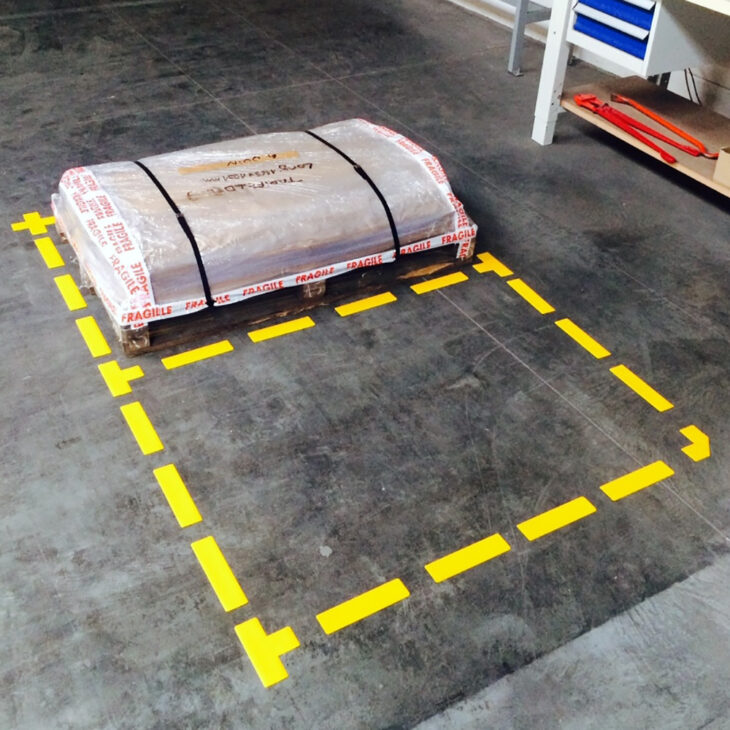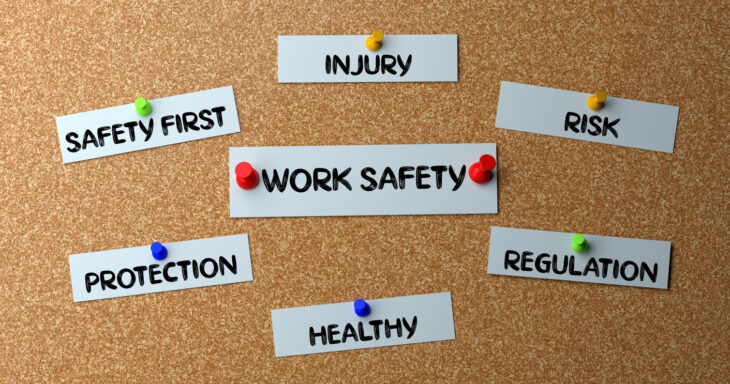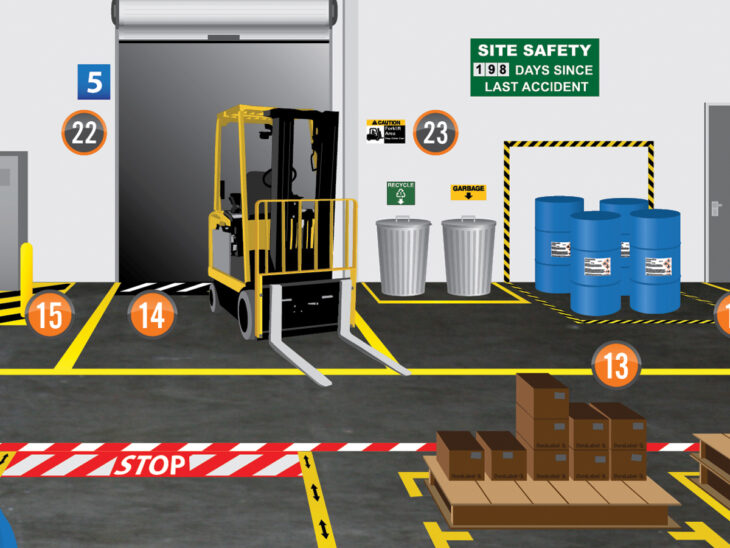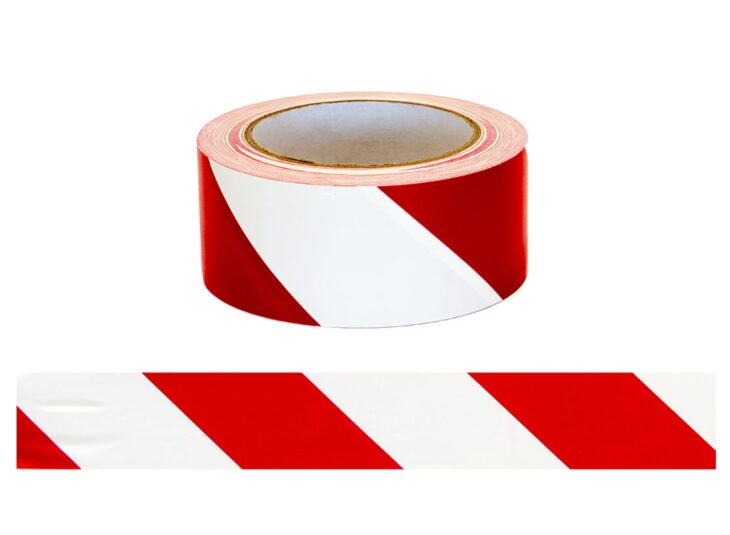Warehouses and industrial facilities are typically bundled together for workplace safety and structure. As seen from the outside, they seem to be quite similar. However, considerable variances exist when making comparisons between the two.
Contents
What Does Floor Marking Tape Mean?
Adhesive tapes used for identifying dangers, dividing areas, creating lanes, and indicating directions are known as floor marking tapes. For floor marking, they are widely utilized in industrial and manufacturing buildings. PVC and vinyl are used to make the floor markings, ranging in thickness, and offering a wide variety of long-lasting options.
In general, the thickest floor marking tapes are between 50 and 60 mils (one-thousandth of an inch) wide. Most of these tapes are available in various colors and even danger patterns to fulfill safety regulations like OSHA/ANSI. Also, high-reflectivity tapes, some of which glow in the dark, are available in most reputed companies like TapeJungle.
Paints and other marking techniques are often replaced with floor marking tape. It is simpler to apply and remove, and it takes up less space when you are not using it. When used in industrial settings, floor marking tape is generally made to endure a great deal of physical wear and tear.
How do Markings Increase Floor Safety?

Source: kasama.us
A safe workplace can be promoted and maintained by using visual communication. Unfortunately, people think of safety posters, warning signs, and caution tape about visual communication. These are all accurate answers, but floor markings are crucial! Using floor markers like tape, forms, projections, and signage, you can make any workstation safer, whether in a factory, construction site, or warehouse.
Equipment Marking
Industrial-grade floor tape is one of the most often used floor marking equipment. Using floor marking tape to assist guests in finding their way around your building is an excellent use for the product. Forklifts, industrial vehicles, and pedestrians all use the same area. However, they all have their special lanes, thanks to floor tape.
In addition, the application of hazard tape around dangerous machinery can warn workers of the potential for harm. Floor tape can also denote “Do Not Enter” zones and mark aisleways.
Vivid Indicators
The usage of floor signs is also included in applying floor markings. Floor signs can be used to transmit the same information as wall signage. Floor signs include anything from stop and yield signs to hazard and personal protective equipment (PPE) signals.
Workers might sometimes become “blind” to warning indicators for their safety. For a year, they must view the same warning notice on the wall, and as a result, their brain begins to ignore it. But floor signs are a cost-efficient and effective method of distributing these reminders.
Workplace Safety Program

Source: sboneinsurance.com
Floor tape, forms, and signage are not limited to a single business. Floor markings are an essential part of any workplace safety program. The risk of accidents and injuries can be significantly reduced by working with other departments and devising a strategy to deploy floor markings.
Emergency Action Plan (EAP)
Your emergency action plan (EAP) and preparation are both aided by floor markings. Floor marking that can be seen at any time of day or night can help you be prepared in the event of an emergency, such as a fire, a chemical spill, or any other natural catastrophe. In addition, the glow-in-the-dark tape may be used to help personnel and visitors find their way out of the building in the event of an emergency.
Fire extinguishers and other emergency equipment might be blocked by people if they are not correctly marked. Check your state’s building rules to ensure you have completed all required marks in your structure.
Overall Safety
Floor markings may maintain your current safety initiatives. What parts of your workplace may benefit from floor markings? To make workspaces more easily understood, use floor tape to emphasize critical signs on the floor.
Use tape to emphasize places in your workplace that may go unnoticed, such as electrical outlets, control panels, and door access. Anything that might need a little more attention should be on your radar.
Fluorescent and reflective tapes should be used to mark potentially dangerous structures and things, such as beams, bollards, ramps, and loading docks.
Focus on bottlenecks and locations where workers regularly commit mistakes to avoid wasting time and money. Colorful lines and stripes may be used to draw boundaries. Dots, footprints, and other pre-cut forms may effectively direct personnel and visitors throughout the facility.
Color Guide

Source: prweb.com
Here is the color guide for marking tapes.
White Floor Tape
White tape is the way to go when it comes to items like racks, carts, and other facility equipment. White tape outlines them so that people are aware of their existence and know where to dispose of them after they are done utilizing them.
Yellow Floor Tape
In addition to car traffic, yellow tape or paint should be utilized for any regular indoor and outdoor foot traffic. The yellow tape can also be used to demarcate even the tiniest of workspaces.
Blue/Green/Black Floor Tape
They are commonly used interchangeably because of the difficulty distinguishing them in darker environments. They are often found near raw materials and the stages of production of both completed things and unfinished ones.
Red Floor Tape
It is utilized where faulty goods, scrap materials, or objects in the plant that need to be reworked are held.
Orange Floor Tape
Products, materials, or supplies awaiting examination are temporarily on hold.
Black & White Floor Tape
Black and white tape should be used to identify areas that must be maintained free of obstructions for normal business operations. This should not be utilized in emergency or compliance situations.
Red & White Floor Tape

Source: eskosafety.com
Red and white tape should be used to designate any area that has to be maintained free for safety or compliance reasons. For example, fire extinguishers, eyewash stations, and fire lanes are common locations for this sign.
Black & Yellow Floor Tape
Black and yellow tape should be used to designate any place that can pose a threat to someone’s health.
Conclusion
A safe and productive workplace necessitates the use of floor markers. Time and money are saved by using suitable material for the work. Even if you employ floor marking, the key to its success is a well-thought-out execution.
Create a workplace where employees and visitors can see how every part of the facility works. If you are looking to limit the amount of clutter and the danger of harm in your workplace, floor markings are an excellent way to go about it.
